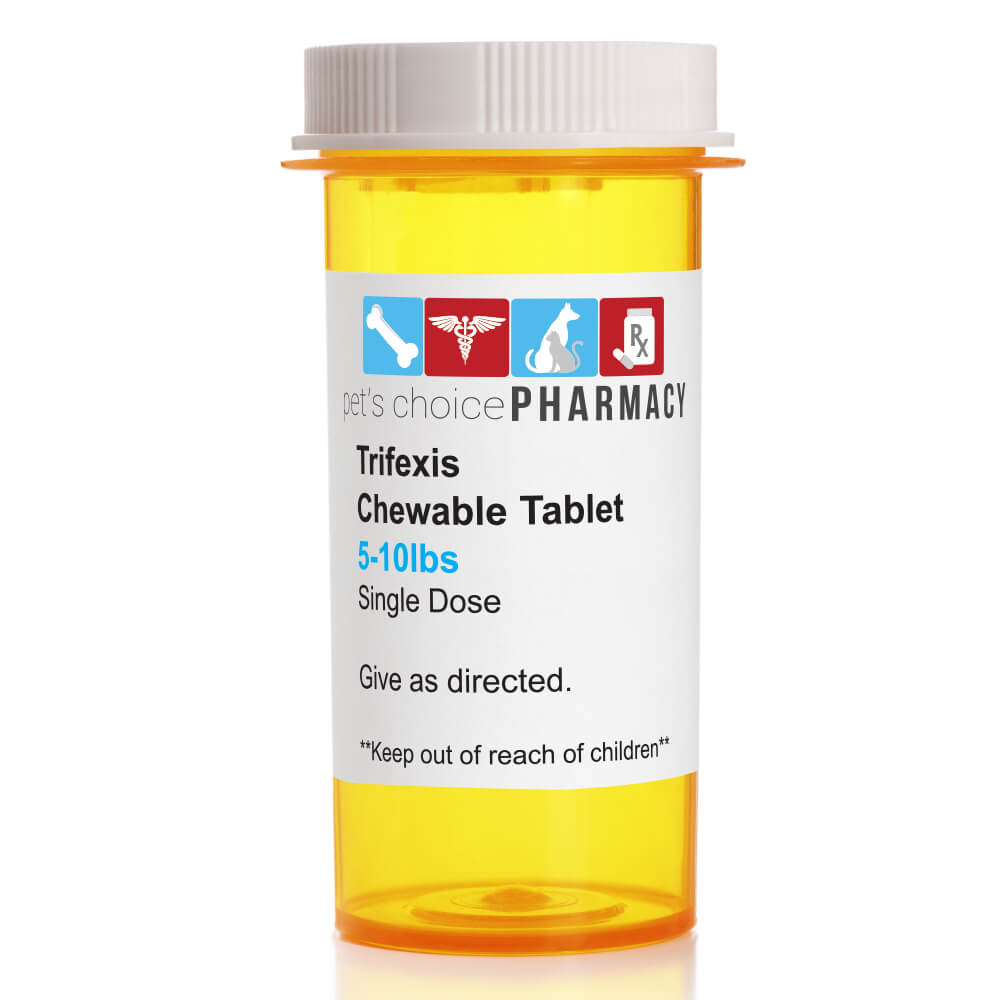Payment & Security
Your payment information is processed securely. We do not store credit card details nor have access to your credit card information.
Description
Rx Trifexis 5–10 lbs (Pink) x 1 Tablet
Trifexis® (spinosad + milbemycin oxime) is a monthly oral medication that provides complete parasite protection for small dogs weighing 5–10 lbs. This beef-flavored chewable starts killing fleas within 30 minutes, prevents heartworm disease, and treats and controls hookworms, roundworms, and whipworms.
Safe for dogs and puppies 8 weeks of age or older and weighing at least 5 lbs., Trifexis offers fast-acting, broad-spectrum protection that keeps your pet parasite-free year-round.
Key Benefits:
-
Heartworm Prevention – Monthly dosing prevents deadly heartworm disease.
-
Fast Flea Elimination – Starts killing fleas in 30 minutes, stopping egg laying before it begins.
-
Broad Spectrum Parasite Control – Treats and controls hookworms, roundworms, and whipworms.
-
Beef-Flavored Chewable – Easy to give, enjoyed like a treat.
-
Convenient Monthly Dosing – One chewable simplifies parasite protection.
Active Ingredients (per tablet): Spinosad 140 mg, Milbemycin oxime 2.3 mg.
Storage: Store at 68°–77°F (20°–25°C); excursions permitted 59°–86°F (15°–30°C). Keep out of reach of children and pets.
Keep away from children and other household pets.
This item is not returnable or refundable.
Sold in Qty. of 1 tablet (Pink, for dogs 5–10 lbs.).
| Product type: | Animal Health & Wellness > Flea & Tick Control |
| Brand: | Elanco |
| Size: | 5-10lbs (Pink) |
| Status: | Available |
| Animal type: | Dog |
| Ingredients: | 140 mg spinosad and 2.3 mg milbemycin oxime |
| Storage & Disposal: | Store at 20-25°C (68-77°F), excursions permitted between 15-30°C (59-86°F). |
| Cautions & Warnings: | Not for human use. Keep this and all drugs out of the reach of children. Serious adverse reactions have been reported following concomitant extra-label use of ivermectin with spinosad alone, a component of TRIFEXIS (see ADVERSE REACTIONS). TRIFEXIS was tested in pure and mixed breeds of healthy dogs in well-controlled clinical and laboratory studies. No dogs were withdrawn from the field studies due to treatment-related adverse reactions. In a margin of safety study, TRIFEXIS was administered orally to 8-week-old Beagle puppies at doses of 1, 3, and 5 times the upper half of the therapeutic dose band, every 28 days for 6 dosing periods. Vomiting was seen in all groups including control animals with similar frequency. Adverse reactions seen during the course of the study were salivation, tremors, decreased activity, coughing and vocalization. Body weights were similar between control and treated groups throughout the study. Treatment with TRIFEXIS was not associated with any clinically significant hematology, clinical chemistry or gross necropsy changes. One 5X dog had minimal glomerular lipidosis observed microscopically. The clinical relevance of this finding is unknown. Plasma spinosyn A, spinosyn D, milbemycin A3 5-oxime and milbemycin A4 5-oxime concentrations increased throughout the study. At each dosing period, plasma spinosyn A and spinosyn D concentrations were greater than proportional across the dose range 1 to 5X. Plasma milbemycin A4 5-oxime concentrations appeared to be dose proportional across range 1 to 5X by the end of the study. Plasma concentrations of spinosad and milbemycin oxime indicate that expected systemic exposures were achieved throughout the study. In an avermectin-sensitive Collie dog study, TRIFEXIS was administered orally at 1, 3, and 5 times the upper half of the recommended therapeutic dose band every 28 days. No signs of avermectin sensitivity were observed after administration of TRIFEXIS during the study period to avermectin-sensitive Collie dogs. The adverse reactions observed in the treatment groups were vomiting and diarrhea. Body weights in all treatment groups were comparable to the control group. Hematology and clinical chemistry parameters showed no clinically significant changes from study start to end, and all dogs were considered healthy throughout the study. In a heartworm positive safety study, TRIFEXIS was administered orally at 1, 3, and 5 times the upper half of the therapeutic dose band to Beagle dogs with adult heartworm infections and circulating microfilariae, every 28 days for 3 treatments. Vomiting was observed in one dog in the 1X group, in three dogs in the 3X group, and in one dog in the 5X group. All but one incident of vomiting was observed on the treatment day during the first treatment cycle. The vomiting was mild and self-limiting. Hypersensitivity reactions were not observed in any of the treatment groups. Microfilariae counts decreased with treatment. In a reproductive safety study, TRIFEXIS was administered orally to female dogs at 1 and 3 times the upper half of the therapeutic dose band every 28 days prior to mating, during gestation and during a six-week lactation period. Dogs with confirmed fetal heartbeats on ultrasound examination were evaluated for reproductive safety. One 3X and one 1X group female did not become pregnant. No treatment-related adverse reactions or signs of avermectin toxicosis were noted for adult females. Adult females in the 3X group lost weight during the 6-week pre-mating period, while control group females gained weight during that time. The body weights of the treated groups were comparable to the control group during gestation and post-parturition phases of the study. Gestation length, litter average body weight, litter size, stillborn pups, pup survival and the proportion of pups with malformations were comparable between treated and control dam groups. Malformations in the 1X group included a pup with cleft palate and a littermate with anophthalmia, fused single nares, misshapen palate, hydrocephalus, omphalocele and malpositioned testes; a pup with a malformation of the anterior tip of the urinary bladder and umbilical blood vessel; and a pup with patent ductus arteriosus (PDA). Malformations in the 3X group included three littermates with PDA. Malformations in the control group included a pup with a malformed sternum and a pup with PDA and a malpositioned superior vena cava. Clinical findings in pups of the treated groups were comparable to the control group except for one 1X group pup that was smaller and less coordinated than its littermates and had tremors when excited. The relationship between spinosad and milbemycin oxime treatment and the 1X and 3X dogs that did not become pregnant, the specific pup malformations and the unthrifty 1X group pup are unknown. The incidence of cleft palate is not unexpected based on the historical data collected at the breeding site. In a margin of safety study with spinosad alone, 6-week old Beagle puppies were administered average doses of 1.5, 4.4, and 7.4 times the maximum recommended dose at 28-day intervals over a 6-month period. Vomiting was observed across all treatments, including controls, and was observed at an increased rate at elevated doses. Vomiting most often occurred 1 hour following administration and decreased over time and stabilized when puppies reached 14 weeks of age. |
| Dosage instructions: | TRIFEXIS is given orally, once a month at the minimum dosage of 13.5 mg/lb (30 mg/kg) spinosad and 0.2 mg/lb (0.5 mg/kg) milbemycin oxime body weight. For heartworm prevention, give once monthly for at least 3 months after exposure to mosquitoes (see EFFECTIVENESS).Dosage Schedule: Body Weight Spinosad Per Tablet (mg) Milbemycin oxime Per Tablet (mg) Tablets Administered 5 to 10 lbs 140 2.3 One 10.1 to 20 lbs 270 4.5 One 20.1 to 40 lbs 560 9.3 One 40.1 to 60 lbs 810 13.5 One 60.1 to 120 lbs 1620 27 One Over 120 lbs Administer the appropriate combination of tablets Administer TRIFEXIS with food for maximum effectiveness. To ensure heartworm prevention, owners should observe the dog for one hour after dosing. If vomiting occurs within an hour of administration, redose with another full dose. If a dose is missed and a monthly interval between doses is exceeded, then immediate administration of TRIFEXIS with food and resumption of monthly dosing will minimize the opportunity for the development of adult heartworm infections and flea reinfestations Heartworm Prevention: TRIFEXIS should be administered at monthly intervals beginning within 1 month of the dog’s first seasonal exposure and continuing until at least 3 months after the dog’s last seasonal exposure to mosquitoes (see EFFECTIVENESS). TRIFEXIS may be administered year round without interruption. When replacing another heartworm preventative product, the first dose of TRIFEXIS should be given within a month of the last dose of the former medication. Flea Treatment and Prevention: Treatment with TRIFEXIS may begin at any time of the year, preferably starting one month before fleas become active and continuing monthly through the end of flea season. In areas where fleas are common year-round, monthly treatment with TRIFEXIS should continue the entire year without interruption. To minimize the likelihood of flea reinfestation, it is important to treat all animals within a household with an approved flea protection product. Intestinal Nematode Treatment and Control: TRIFEXIS also provides treatment and control of roundworms (T. canis, T. leonina), hookworms (A. caninum) and whipworms (T. vulpis). Dogs may be exposed to and can become infected with roundworms, whipworms and hookworms throughout the year, regardless of season or climate. Clients should be advised of measures to be taken to prevent reinfection with intestinal parasites. Contraindications: There are no known contraindications to the use of TRIFEXIS |
| Weight: | 0.01 |
| Prescription required: | YES |

